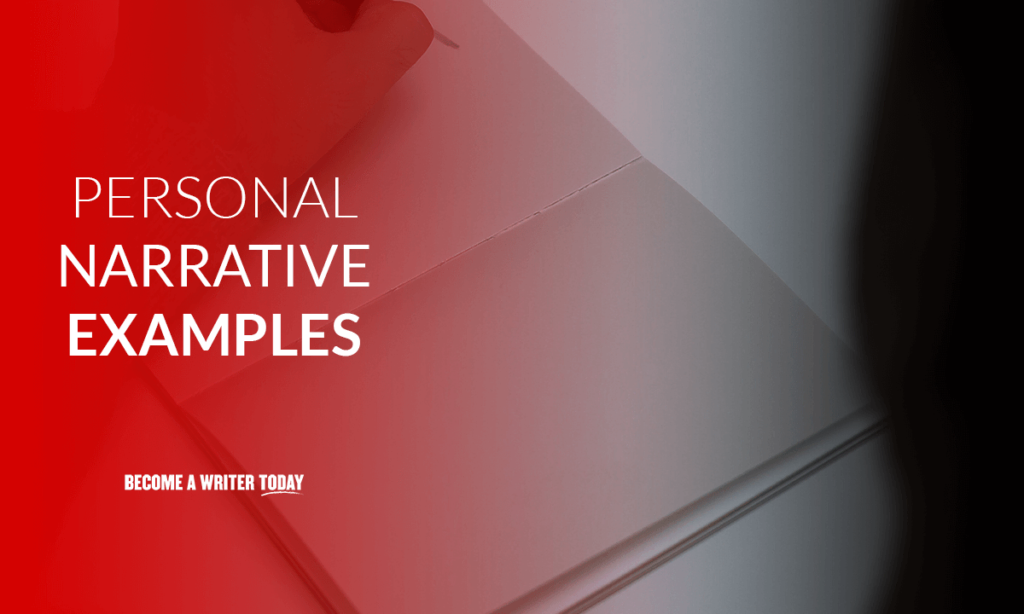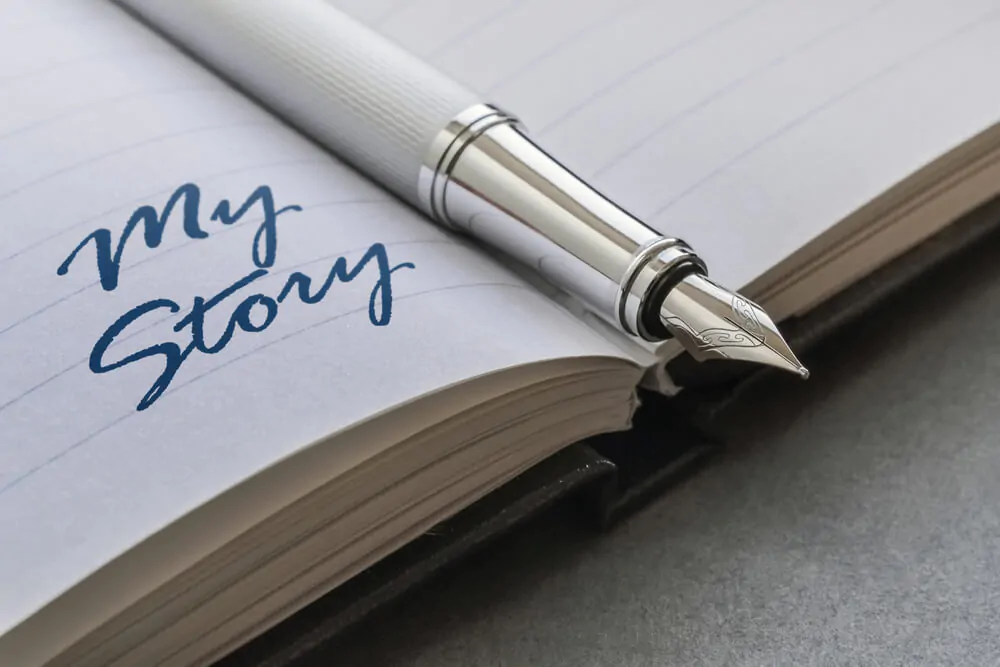
Personal Narrative Examples: 10 Top Examples
These personal narrative examples show some of the best of what you can accomplish in this literary genre.
A personal narrative isn’t a recitation of facts. Rather, it is a nonfiction story told from a first-person point of view. It uses the tools of creative writing but is based on fact and personal experiences. Many people’s first time writing this sort of essay is for a college application. However, many writers also choose this sort of essay writing to hone their literary skills.
Reading the top personal narrative examples can help you get a better understanding of what works and why. You might also be interested in these 5 subjunctive mood examples from famous works of literature .
- 1. Me Talk Pretty One Day – David Sedaris
- 2. Mother Rage: Theory and Practice by Anne Lamott
- 3. Stalking a Rustically Hip Family on Instagram by Emily Flake
4. My Wife Is the Breadwinner (and I Still Haven’t Told My Father) by Mike Harvkey
- 5. Your Brain’s Response to Your Ex According to Neuroscience by Amy Paturel
6. Let’s Meet Again in Five Years by Karen B. Kaplan
7. goodbye to all that by joan didion.
- 8. Here Is a Lesson in Creative Writing by Kurt Vonnegut
9. The Death of the Moth by Virginia Woolf
10. shooting an elephant by george orwell, the final word on personal narrative examples, how do you write a personal narrative, what are some ideas for a personal narrative, 1. me talk pretty one day – david sedaris.

David Sedaris has entranced audiences with his personal narrative essays for decades. The subject matter of his essays includes everything from stories about growing up in Raleigh, North Carolina, exploring his heritage, his youthful rampant drug use and other experiences that many people would have a hard time disclosing so openly and humorously.
“Me Talk Pretty One Day” is both the title of one of his collections and one of the essays presented in it. In the essay, he relates his experience taking French language classes. In between recounting events, he discusses the insecurity that he felt being in a new place at the beginning of the learning curve for a new skill:
When called upon, I delivered an effortless list of things I detest: blood sausage, intestinal pâté, brain pudding. I’d learned these words the hard way. Having given it some thought, I then declared my love for IBM typewriters, the French word for “bruise,” and my electric floor waxer.
It was a shortlist, but still, I managed to mispronounce IBM and afford the wrong gender to both the floor waxer and the typewriter. Her reaction led me to believe that these mistakes were capital crimes in the country of France.

2. Mother Rage: Theory and Practice by Anne Lamott
Anne Lamott’s work runs the gamut from short stories, to essays, to novels, to books on writing. In “Mother Rage,” she recounts experiences of losing her temper at her son and saying awful things to him. Her word choice is often playful and ironic, but the issues she raises are deep and personal ones regarding our relationships with our children and our responsibilities to them.
So: I woke up one recent morning and lay in bed trying to remember if the night before I had actually threatened to have my son’s pets put to sleep, or whether I had only insinuated that I would no longer intercede to keep them alive when, due to his neglect, they began starving to death. I’m pretty sure I only threatened to not intercede.
3. Stalking a Rustically Hip Family on Instagram by Emily Flake

In this essay, Emily Flake muses on the parasocial relationship with have with the people we hate-follow on social media. She recounts her obsession with a particular family of influencers and how looking at them made her more aware of her own insecurities and feelings of inadequacy:
The woman in the photograph looks out at me with a face full of exhaustion and bliss. In her hands, she cradles the purplish, bloody bundle of a just-born child. It’s a beautiful, celebratory image of human existence, as raw and pure and joyful as anything seen through the orderly square of an Instagram post can be. I peer at it in the dark, and hiss-whisper, “How dare you.”
This essay is a great example of how life experiences can be parlayed into a discussion about a cultural shift or another phenomenon. Here, the author discusses his decision with his wife to move for her career while he stayed home and tried his hand at becoming a full-time freelance writer . In addition to the struggles with his new endeavor, he ponders our assumptions about masculinity and what it means to be a provider:
A couple of years back, I quit my job. When I first got this job, my father relaxed. After years of drifting, the boy he’d raised had finally accepted that, like most men, he needed a career so he could support his family. He was proud. And now I was leaving this job because I wanted to write full time and my wife had found a new job that could support us both. I was quitting, and we were moving, so she could become the breadwinner. I couldn’t tell my father this; I still haven’t.
5. Your Brain’s Response to Your Ex According to Neuroscience by Amy Paturel
Paturel buries her thesis statement under several paragraphs of narrative writing and sensory details. This is a personal narrative that functions as the framework for a reported article on the science of what happens in your brain when you are young and fall in love:
He was the first to make me dinner, teach me to surf in ice-cold waters, and unlock the seemingly impenetrable fortress of my body. Together, we formed our identities and defined what love meant. In the process, he ingrained himself into my psyche.
For nearly 20 years, New York Times readers have been able to see a range of personal narrative essay examples on the theme of love and relationships in the paper’s Modern Love column. In this essay, a woman recounts what happened when she and a guy who she’d been dating a few months decided that they were too young for commitment. Rather than making a mistake, they decided to meet again in five years and see if they were ready:
Howard agreed. We settled on meeting at the New York Public Library, near the uptown lion, at 4 p.m. on the first Sunday in April, five years from that spring. We wrote our pledge on a dollar bill, tore it in half, and gave each other the half we’d written on.
Joan Didion writes about her arrival in New York City and her departure eight years later. She talks about her relationship with the city and the ways that we romanticize our youthful experiences:
I was in love with New York. I do not mean ‘love’ in any colloquial way, I mean that I was in love with the city, the way you love the first person who ever touches you and never loves anyone quite that way again.
8. Here Is a Lesson in Creative Writing by Kurt Vonnegut
This short Vonnegut essay is one part writing lesson, one part marketing lesson, one part memoir of the life of a professional writer. You’ve probably seen it quoted before:
Practicing an art, no matter how well or badly, is a way to make your soul grow, for heaven’s sake. Sing in the shower. Dance to the radio. Tell stories. Write a poem to a friend, even a lousy poem. Do it as well as you possibly can. You will get an enormous reward. You will have created something.
During her life, Virginia Woolf struggled with poor mental health and the difficulty of balancing demands on her as a woman with her efforts to write. In this essay, she muses over a small moth in her living room in a way that connects it to her larger struggles:
Yet, because he was so small, and so simple a form of the energy that was rolling in at the open window and driving its way through so many narrow and intricate corridors in my own brain and in those of other human beings, there was something marvelous as well as pathetic about him.
George Orwell is remembered as a political novelist who often worked in allegory. We see an early example of him honing his writing skills in this essay about being forced to shoot a rampaging elephant while stationed in Burma. He links his personal experience to the problem on imperialism and his desire not to be a part of it:
In Moulmein, in Lower Burma, I was hated by large numbers of people — the only time in my life that I have been important enough for this to happen to me. I was a sub-divisional police officer of the town, and in an aimless, petty kind of way anti-European feeling was very bitter. No one had the guts to raise a riot, but if a European woman went through the bazaars alone somebody would probably spit betel juice over her dress. As a police officer, I was an obvious target and was baited whenever it seemed safe to do so.
A personal narrative can be a powerful tool for getting your ideas onto the page. When you begin with highly relatable life experiences, you can segue into any type of essay, from a short memoir to an argumentative essay . Read these and other personal narrative examples to learn more about the form and the best ways to approach it. You might also find our alliteration examples from culture and literature guide helpful.
FAQ About Personal Narrative Examples
The ideal personal narrative draws the reader in with relatable anecdotes and universal observations.
Think about topics that you would want to read about. You can focus on anything from high school from your first time driving as a 16-year-old, to how you met your best friend.

IMAGES
VIDEO